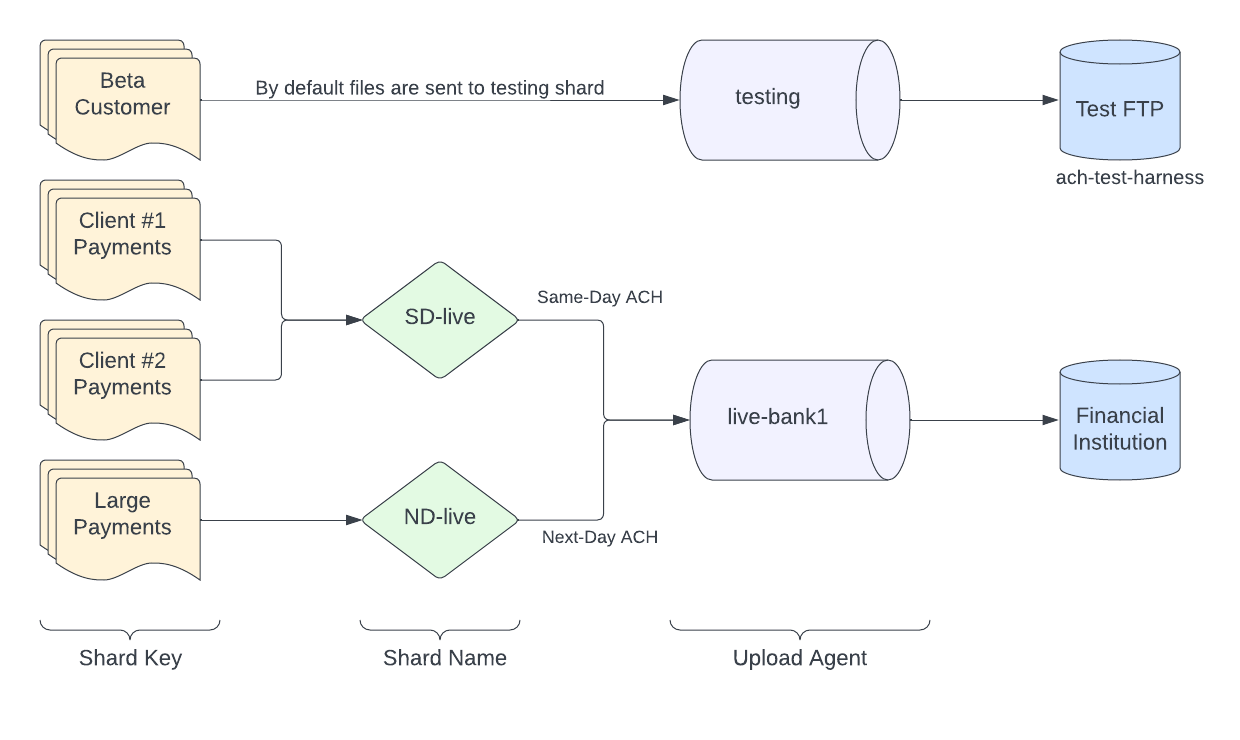Sharding
Shards are defined in ACHGateway as a logical grouping for ACH file delivery. There are countless patterns for describing file delivery within a business according to risk, feature delivery, fund availability, etc. Below is a sample sharding setup:
testing: A shard used for automated and manual verification of the platform/feature. These files are never uploaded to the ODFI.SD-live-bank1: A shard for uploading ACH files according to the Same-Day ACH windows.ND-live-bank1: A shard for uploading ACH files for the last Traditional ACH window.SD-live-bank2: Another FI used as an ODFI.
A business might have several customers that map to each shard. For example every new signup might be mapped to the testing shard until they’re verified and onboarded successfully. Premium customers might be assigned to the SD-live-bank1 window and free users may be mapped to ND-live-bank1.
The mapping is a shardKey (CustomerID, UUID, etc) to the shardName (e.g. SD-live-bank1). This configuration can be managed within ACHGateway via HTTP endpoints or in the config file. Many implementations will also use a 1:1 mapping (SD-live-bank1 -> SD-live-bank1 and another database manages the mapping.
Example: Configure the Sharding object
Shard Configuration
Each shard has a wealth of configuration options, but the major options are:
- Upload Agent: SFTP or FTP transmission
- Cuttoff times: Wall clock times to trigger merge, upload, and notification
- Filename templates: Custom templating of uploaded filenames
- Audit Trail: Encrypted storage of uploaded and downloaded files
- Notifications: Email, PagerDuty, and Slack alerting of successful or failed processing
- Merge conditions: Maximum file dollar amounts, or line length restrictions
Mapping
Refer to the API endpoints for configuring shard mapping.
Filename templates
ACHGateway supports templated naming of ACH files prior to their upload. This is helpful for ODFI’s which require specific naming of uploaded files.Templates use Go’s text/template syntax and are validated when ACHGateway starts or changed via admin endpoints.
Example:
{{ .ShardName }}-{{ date "20060102" }}-{{ .Index }}.ach{{ if .GPG }}.gpg{{ end }}
The following fields are passed to templates giving them data to build a filename from:
ShardName: string of the shard performing an uploadGPG: boolean if file is encryptedIndex: integer starting from 0 of the Nth file uploaded during a cutoff from an ACHGateway instance
Also, several functions are available (in addition to Go’s standard template functions)
dateTakes a GoTimeformat and returns the formatted stringenvTakes an environment variable name and returns the value fromos.Getenv.lowerandupperconvert a string into lowercase or uppercase
Refer to the Shard config section to tweak the OutboundFilenameTemplate.
